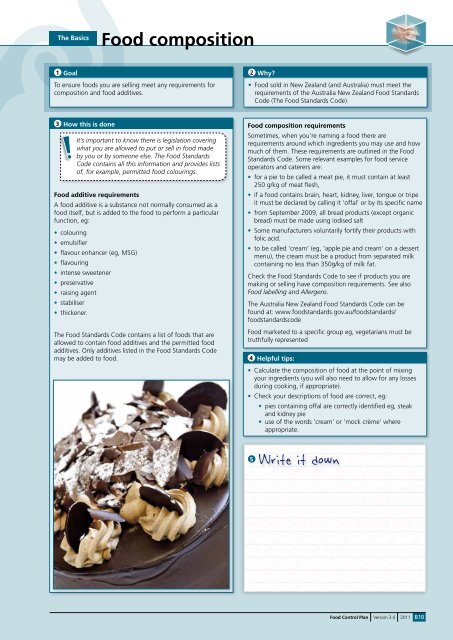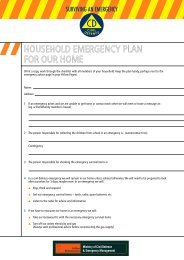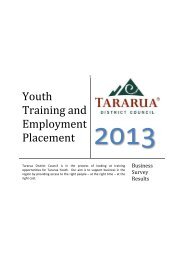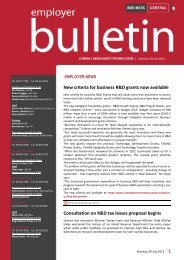Food Control Plan Checklist - Tararua District Council
Food Control Plan Checklist - Tararua District Council
Food Control Plan Checklist - Tararua District Council
- No tags were found...
You also want an ePaper? Increase the reach of your titles
YUMPU automatically turns print PDFs into web optimized ePapers that Google loves.
The Basics<strong>Food</strong> composition1 Goal 2 Why?To ensure foods you are selling meet any requirements forcomposition and food additives.• <strong>Food</strong> sold in New Zealand (and Australia) must meet therequirements of the Australia New Zealand <strong>Food</strong> StandardsCode (The <strong>Food</strong> Standards Code).3 How this is doneIt’s important to know there is legislation coveringwhat you are allowed to put or sell in food madeby you or by someone else. The <strong>Food</strong> StandardsCode contains all this information and provides listsof, for example, permitted food colourings.<strong>Food</strong> additive requirementsA food additive is a substance not normally consumed as afood itself, but is added to the food to perform a particularfunction, eg:• colouring• emulsifier• flavour enhancer (eg, MSG)• flavouring• intense sweetener• preservative• raising agent• stabiliser• thickener.The <strong>Food</strong> Standards Code contains a list of foods that areallowed to contain food additives and the permitted foodadditives. Only additives listed in the <strong>Food</strong> Standards Codemay be added to food.<strong>Food</strong> composition requirementsSometimes, when you’re naming a food there arerequirements around which ingredients you may use and howmuch of them. These requirements are outlined in the <strong>Food</strong>Standards Code. Some relevant examples for food serviceoperators and caterers are:• for a pie to be called a meat pie, it must contain at least250 g/kg of meat flesh,• if a food contains brain, heart, kidney, liver, tongue or tripeit must be declared by calling it ‘offal’ or by its specific name• from September 2009, all bread products (except organicbread) must be made using iodised salt• Some manufacturers voluntarily fortify their products withfolic acid.• to be called ‘cream’ (eg, ‘apple pie and cream’ on a dessertmenu), the cream must be a product from separated milkcontaining no less than 350g/kg of milk fat.Check the <strong>Food</strong> Standards Code to see if products you aremaking or selling have composition requirements. See also<strong>Food</strong> labelling and Allergens.The Australia New Zealand <strong>Food</strong> Standards Code can befound at: www.foodstandards.gov.au/foodstandards/foodstandardscode<strong>Food</strong> marketed to a specific group eg, vegetarians must betruthfully represented4 Helpful tips:• Calculate the composition of food at the point of mixingyour ingredients (you will also need to allow for any lossesduring cooking, if appropriate).• Check your descriptions of food are correct, eg:• pies containing offal are correctly identified eg, steakand kidney pie• use of the words ‘cream’ or ‘mock crème’ whereappropriate.5Write it down<strong>Food</strong> <strong>Control</strong> <strong>Plan</strong> Version 3.0 2011 B10







